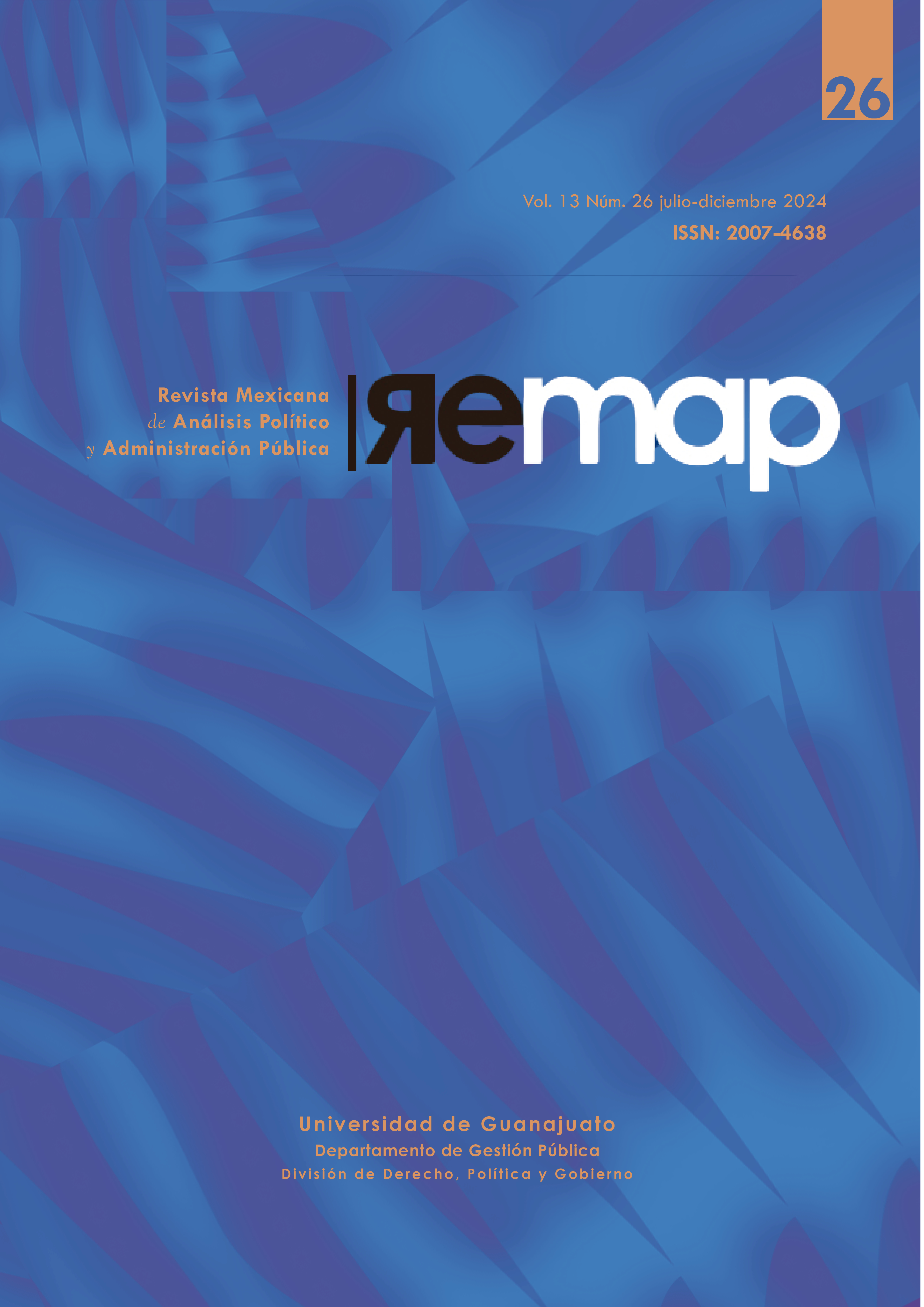SOME PROBLEMS WITH TRANSITION THEORY
DOI:
https://doi.org/10.15174/remap.v13i26.435Keywords:
Transition, Democratic Transition, Democracy, Democratization, Democratic ConsolidationAbstract
The objective of this paper is to review in the long term the theory of transitions to propose some adjustments in it that allow it to overcome several inconsistencies that afflict it from its first developments. Thus, for example, a) when it consider that the actors of change are always the political elites, both of the old regime and the emerging one, to the detriment of social actors and society in general, sins of reductionist; b) it is a very rigid and closed theory in its options, so it underestimates or omits other possible defeats and outcomes; and c) it has become a highly normative view of regime change, insensitive to factors and circumstances not contemplated by the theory, but not irrelevant.
References
AAlmond, G.A, S.C., Flanagan & R.J., Mundt (1973). Crisis, Choice and Change.
Little Brown & Co.
Almond, G.A., & Powell, G.B. Jr. (1978). Comparative Politics. System, Process,
and Policy. Little Brown and Company.
Cansino, C. & Covarrubias, I. (2006), “Estudio preliminar”. En Morlino, L.
Democracias y democratizaciones (pp. 9-21). CEPCOM.
Dahl, R.A. (1971), Poliarchy. Participation and Opposition. Yale University Press.
Downs, A. (1957). An economic theory of democracy. Harper & Row.
Díaz Montiel, A. & Cansino, C. (2016). “Transitología”. En Sánchez Galicia, J.
(coord.) y Cansino, C. (ed.). Treinta claves para entender el poder. Léxico para
la nueva comunicación política (Vol. I, pp. 321-334). México: Piso 15/ICP/
BUAP/CEPCOM.
Easton, D. (1953). The Political System: An Inquiry into the State of Political
Science. New York: Knopf.
Giner, S. (1985). Change for Continuity. [Documento para el European University
Institute, noviembre].
Huntington, S.P. (1968). Political Order in Changing Societies. New Haven: Yale
University Press.
Huntington, S.P. (1991). The Third Wave. Democratization in the Late Twentieth
Century. Norman-Londres: University of Oklahoma Press.
Linz, J. (1978). “Crisis, Breakdown and Reequilibration”. En Linz, J. & Stepan,
A. (eds.). The Breakdown of Democratic Regimes. Baltimore: Johns Hopkins
University Press.
Linz, J. (1986). “Il fattore tempo nei mutamenti di regime”. Teoria Politica, (1), pp.
-48.
Linz, J. & Stepan, A. (1996). Problems of Democratic Transition and
Consolidation: Southern Europe, South America, and PostCommunist
Europe. Baltimore: Johns Hopkins University Press.
Linz, J. & Stepan, A. (eds.) (1978). The Breakdown of Democratic Regimes.
Baltimore: Johns Hopkins University Press.
Lipset, S. M. (1950). Agrarian Socialism. The Cooperative Commonwealth
Federation in Saskatchewan. A Study in Political Sociology. Berkeley:
University of California Press.
Lipset, S. M. (1960). Political Man. The Social Bases of Politics. Garden City,
Nueva York: Doubleday & Company, Inc.
Lipset, S. M., & Rokkan, S. (1967). “Cleavage structures, party systems, and voter
alignments: An introduction”. En Party systems and voter alignments: Crossnational
perspectives (pp. 1-64). Free Press.
Morlino, L. (1980). Come cambiano i regimi politici? Milán: Franco Angeli.
Morlino, L. (2006). Democracias y democratizaciones. México: CEPCOM.
O’Donnell, G. (1973). Modernization and Bureaucratic-Authoritarianism; Studies
in South American Politics. Los Angeles: University of California.
O’Donnell, G., & Schmitter, P.S. (1986). “Transition from Authoritarian Rule.
Tentative Conclusions about Uncertain Democracies”. En O’Donnell, G.,
Schmitter, P.S., & Whitehead, L. (eds.), Transitions from Authoritarian Rule
(Vol. 4, pp. 1-81). Baltimore: The Johns Hopkins University Press.
O’Donnell, G., Schmitter, P.S. & Whitehead, L. (eds.) (1986). Transition from
Authoritarian Rule. Baltimore: The John Hopkins University Press.
Przeworski, A. (1986). “Some Problems in the Study of the Transitions to
Democracy”. En O’Donnell, G., Schmitter, P.S. & Whitehead, L. (eds.) (1986),
Transition from Authoritarian Rule (vol. 3). Baltimore: The John Hopkins
University Press.
Przeworski, A. (2000). Capitalismo y socialdemocracia. México: Alianza.
Rustow, D.A. (1970). “Transition to Democracy: Toward a Dynamic Model”.
Comparative Politics, (2), pp. 337-363.
Rustow, D.A. & Erickson, K.P. (1990). Comparative Political Dynamics. Global
Research Perspectives. Nueva York: Harper Collins.
Santamaría, J. (ed.) (1982). Transición a la democracia en el sur de Europa y
América Latina. Madrid: Centro de Investigaciones Sociológicas.
Schumpeter, J. A. (1996). Capitalismo, socialismo y democracia (Vol. I). Ediciones
Folio. (Trabajo original publicado en 1942).
Stepan, A. (1986). “Paths toward Redemocratization: Theoretical and
Comparative Considerations”. En O’Donnell, G., Schmitter, P.S &
Whitehead, L. (eds.) (1986).
Weber, M. (1922). Economía y Sociedad: Esbozo de Sociología Comprensiva
[Wirtschaft und Gesellschaft: Grundriss der verstehenden Soziologie].
Tubinga, Alemania: Mohr Siebeck.
Downloads
Published
How to Cite
Issue
Section
License
Copyright (c) 2024 César Cansino

This work is licensed under a Creative Commons Attribution-NonCommercial-NoDerivatives 4.0 International License.
Los autores conservan los derechos de autor y deberán proporcionar por escrito la autorización para la primera publicación, vía red de cómputo e impresa a REMAP. Se permite a terceros utilizar lo publicado siempre que se dé el crédito adecuado y sin propósitos comerciales.
Esta obra está bajo una licencia Attribution-NonCommercial-NoDerivs 4.0 International.
